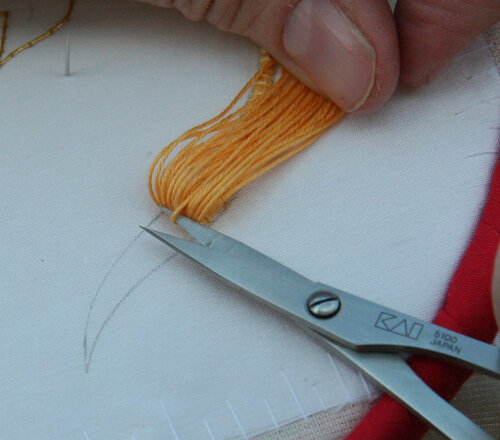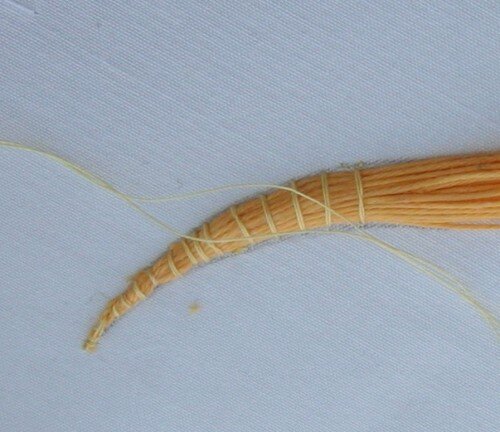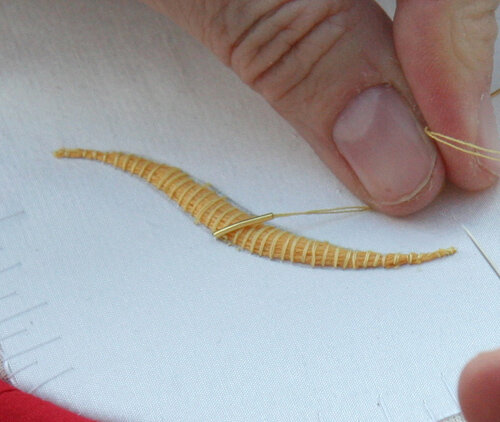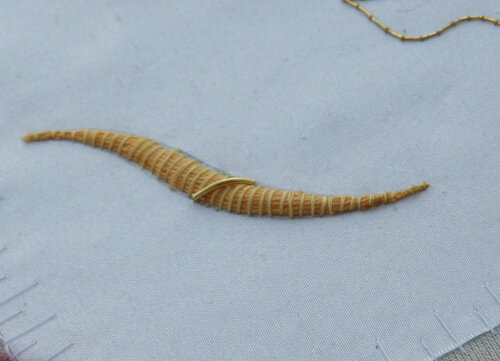String padding
The last goldwork technique Nicola Jarvis worked on with me was string padding. The tapered padding is the base for cut work using purl thread.To begin, we cut lots of pieces of string padding to the same length and then waxed them as a group quite heavily. The wax helps the strings to stick together. The strings are cut longer than the length of the shape, as you can see below. I began to couch the string padding in the middle of the shape. For the first few couching stitches, I stitched down all of the strings with the couching stitches perpendicular to the string padding.After putting in those first few stitches, which are about 1 cm apart, it was time to begin to reduce the thickness of the string padding as I worked towards the end of the long, narrow shape. The technique used to reduce the thickness of the padding involves lifting all of the threads and gently folding them backwards. The fold must be quite loose so that the individual strings separate slightly from the bunch.
I began to couch the string padding in the middle of the shape. For the first few couching stitches, I stitched down all of the strings with the couching stitches perpendicular to the string padding.After putting in those first few stitches, which are about 1 cm apart, it was time to begin to reduce the thickness of the string padding as I worked towards the end of the long, narrow shape. The technique used to reduce the thickness of the padding involves lifting all of the threads and gently folding them backwards. The fold must be quite loose so that the individual strings separate slightly from the bunch. Using my very sharp, finely pointed scissors I then snipped off 4 - 5 strings from the underside of the bunch. I cut the strings at slightly different places so the ends weren't all the same length. This allows the taper of the padding to be nice and smooth. Nicola explained that I needed to cut a string from the middle and a couple from each side, preferably not right together. All the strings are cut from the under side of the padding, which is why it is folded back.
Using my very sharp, finely pointed scissors I then snipped off 4 - 5 strings from the underside of the bunch. I cut the strings at slightly different places so the ends weren't all the same length. This allows the taper of the padding to be nice and smooth. Nicola explained that I needed to cut a string from the middle and a couple from each side, preferably not right together. All the strings are cut from the under side of the padding, which is why it is folded back. Once I reached the end of the first side, it was time to make a small, straight stitch from the tip into the string padding. Then I stitched two or three tiny stitches over the straight stitch and worked my way back to the middle, putting in couching stitches between the ones I'd previously done. By the time I'd reached the middle again, the couching stitches were now 0.5 cm apart since I'd filled in between the first ones with the second ones. This make the string padding firmer on the fabric but avoids the string padding bunching up because the first stitches are too close together.As I worked my way to the other end, it was much more relaxing to do that half of the shape. The first time I do anything - stitching, yoga, driving, teaching -anything! - I find it very difficult. My confidence isn't very high until I've experienced something and can gauge for myself how easy or difficult it will be for me. It doesn't matter if it's easy or difficult, I just need to know what to expect and begin to work out my own strategy and method for doing the new task.Attaching the purl was fun. Cutting it to the exact length needed is a bit tricky: it's going to take time for my eye to judge how long I need to cut each piece. I asked Nicola if she measured her purl thread before cutting it and she said no. She assured me my ability to judge how long each piece needed to be would improve quickly. I hope so!
Once I reached the end of the first side, it was time to make a small, straight stitch from the tip into the string padding. Then I stitched two or three tiny stitches over the straight stitch and worked my way back to the middle, putting in couching stitches between the ones I'd previously done. By the time I'd reached the middle again, the couching stitches were now 0.5 cm apart since I'd filled in between the first ones with the second ones. This make the string padding firmer on the fabric but avoids the string padding bunching up because the first stitches are too close together.As I worked my way to the other end, it was much more relaxing to do that half of the shape. The first time I do anything - stitching, yoga, driving, teaching -anything! - I find it very difficult. My confidence isn't very high until I've experienced something and can gauge for myself how easy or difficult it will be for me. It doesn't matter if it's easy or difficult, I just need to know what to expect and begin to work out my own strategy and method for doing the new task.Attaching the purl was fun. Cutting it to the exact length needed is a bit tricky: it's going to take time for my eye to judge how long I need to cut each piece. I asked Nicola if she measured her purl thread before cutting it and she said no. She assured me my ability to judge how long each piece needed to be would improve quickly. I hope so! I brought the needle up from the back at the bottom of the string padding, slid the purl onto the needle and down the thread. I then took the needle down at the top of the padding. The first piece of purl determines the angle for all the rest of the pieces of purl. When working from the center to the right of the shape, you should bring you needle up very close to the previous piece of purl on the bottom of the string padding. Take the needle back down leaving a space the width of the purl on the top side of the padding. When working from the center to the left, the reverse applies.
I brought the needle up from the back at the bottom of the string padding, slid the purl onto the needle and down the thread. I then took the needle down at the top of the padding. The first piece of purl determines the angle for all the rest of the pieces of purl. When working from the center to the right of the shape, you should bring you needle up very close to the previous piece of purl on the bottom of the string padding. Take the needle back down leaving a space the width of the purl on the top side of the padding. When working from the center to the left, the reverse applies. These few lessons were a great way to feel more comfortable with these techniques. Now, when I read any of my books on goldwork, I will have a better idea of what to do. Being shown a technique in combination with reading about it is the best way for me to learn. It also helps me enormously to write about it: it's another way of reinforcing my learning. I will be doing more work at home in the coming weeks on gold work techniques and sharing it with all of you.As I was learning these techniques, what I couldn't help thinking about was "Who in the world thought of all this? And why? What drove them to make things beautiful rather than simply utilitarian? How many times did they fail before the were assured of success?"Being part of the long line of embroiderers gives me a connection to the past that sometimes is just magical, isn't it?
These few lessons were a great way to feel more comfortable with these techniques. Now, when I read any of my books on goldwork, I will have a better idea of what to do. Being shown a technique in combination with reading about it is the best way for me to learn. It also helps me enormously to write about it: it's another way of reinforcing my learning. I will be doing more work at home in the coming weeks on gold work techniques and sharing it with all of you.As I was learning these techniques, what I couldn't help thinking about was "Who in the world thought of all this? And why? What drove them to make things beautiful rather than simply utilitarian? How many times did they fail before the were assured of success?"Being part of the long line of embroiderers gives me a connection to the past that sometimes is just magical, isn't it?
